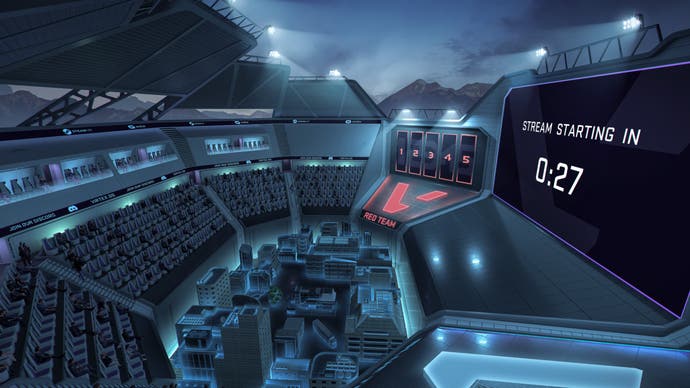Counter-Strike is getting a virtual esports stadium
From VR company Virtex.
Virtex is launching the first ever virtual esports stadium to allow viewers to watch matches from inside the arena - and the game's map.
The software developer has partnered with spectating and analysis platform Skybox to create the Virtex Stadium, which will launch with Counter-Strike (both CS:GO and Counter-Strike 2 will be compatible).
The virtual stadium is currently available in closed beta via desktop and compatible VR headsets.
Viewers will get a fully 3D experience: not only spectating from seats around a virtual stadium, but entering the map itself to view matches from up close.
The virtual stadium also includes a lobby area, lounge bar, and main hall in which to meet friends and fans, which players explore using customisable avatars. The aim of the Virtex Stadium is to allow viewers to watch events live from around the globe.


"We are thrilled to be introducing a massive title like Counter-Strike to the Virtex Stadium and giving more fans the opportunity to enjoy top-level gameplay in a way that's never been done before," Virtex co-founder Tim McGuinness said.
"As the third-most watched esport last year, CS:GO already has an enormous following and we're excited to be working with Skybox to deliver a 360-degree spectating experience unique to every fan. As a die-hard esports fan I can't wait to announce more of the upcoming tournaments we are set to feature in the stadium."
Counter-Strike is the second esports game to feature on the platform, following Echo VR's integration with the Virtex Stadium last year.
"In terms of expanding the esports audience I'd say our main offering there would be giving viewers the ability to get closer to the action (quite literally) than ever before, experiencing the event like you were actually there and doing it all with friends and fans from all around the world," McGuinness told Eurogamer.
-(1)-(1).png?width=690&quality=75&format=jpg&auto=webp)
-(1)-(1).png?width=690&quality=75&format=jpg&auto=webp)
There could also be an impact for esports casters too. "We're definitely open to exploring the idea of allowing creators to augment the broadcast as part of the Virtex Stadium experience but we'd consider this more experimental territory right now whilst we work on delivering the best possible virtual stadium experience we can," he said.
For now, the aim is to have a "positive meaningful impact" on the wider esports industry. "Given that streaming content into Virtex Stadium is an additional avenue on top of either a live video broadcast or real in-stadium event, by pushing that existing content into a new experience at no cost to the creator or user we really hope to give some of the tools to engage with fans/create immersive experiences/monetise in scalable ways that games have and hand it over to organisers and teams in a way that only provides upside for both them and their fans," McGuinness said.
Partnering with Counter-Strike was also a natural choice.
"Since the very beginning we always wanted to prove we can deliver an FPS style game as part of a compelling 3D experience so Counter-Strike became one of the go to titles to allow us to prove it was possible, that you can watch a game of Counter-Strike like you'd watch a real sport in a real stadium," McGuinness said, also confirming Counter-Strike 2 will be fully supported on its release this summer.
There could even be a use for this technology outside of esports too - imagine watching a virtual concert like this! Said McGuinness: "Bringing other content outside of esports is definitely something very interesting and we get asked about it quite often, given that we have developed the technology needed to deliver live 3D content in a real time, cost efficient manner, it has a lot of very interesting potential use cases.
"Right now our core focus however is really on delivering the best possible stadium experience for fans of esports, however keep an eye out and you might see some R&D work coming out from us a little later this year."
For more information about the beta test, visit the Virtex Stadium website.


